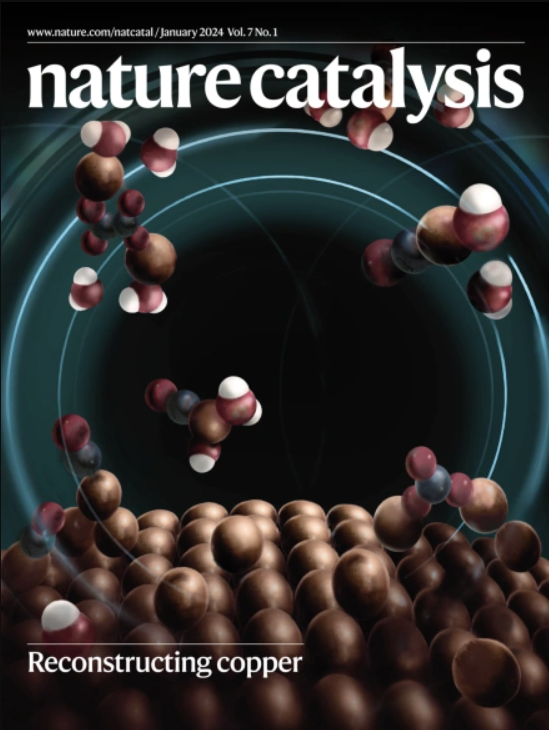Ligand binding to a Ni–Fe cluster orchestrates conformational changes of the CO-dehydrogenase–acetyl-CoA synthase complex
IF 44.6
1区 化学
Q1 CHEMISTRY, PHYSICAL
引用次数: 0
Abstract
Catalytic metal clusters play critical roles in important enzymatic pathways such as carbon fixation and energy conservation. However, how ligand binding to the active-site metal regulates conformational changes critical for enzyme function is often not well understood. One carbon fixation pathway that relies heavily on metalloenzymes is the reductive acetyl-coenzyme A (acetyl-CoA) pathway. In this study, we investigated the catalysis of the last step of the reductive acetyl-CoA pathway by the CO-dehydrogenase (CODH)–acetyl-CoA synthase (ACS) complex from Carboxydothermus hydrogenoformans, focusing on how ligand binding to the nickel atom in the active site affects the conformational equilibrium of the enzyme. We captured six intermediate states of the enzyme by cryo-electron microscopy, with resolutions of 2.5–1.9 Å, and visualized reaction products bound to cluster A (an Ni,Ni-[4Fe4S] cluster) and identified several previously uncharacterized conformational states of CODH–ACS. The structures demonstrate how substrate binding controls conformational changes in the ACS subunit to prepare for the next catalytic step. The CO dehydrogenase–acetyl-coenzyme A synthase complex produces acetyl-coenzyme A from CO2, but its structural dynamics during catalysis remain unresolved. Now cryo-EM maps of six intermediate states reveal how ligand binding to a Ni–Fe cluster orchestrates the conformational changes of the complex during catalysis.


配体与Ni-Fe簇结合可协调co -脱氢酶-乙酰-辅酶a合成酶复合物的构象变化
催化金属团簇在固碳和节能等重要的酶促过程中起着至关重要的作用。然而,配体与活性位点金属的结合如何调节对酶功能至关重要的构象变化通常还不太清楚。一种高度依赖金属酶的碳固定途径是还原性乙酰辅酶A (acetyl-CoA)途径。在本研究中,我们研究了CO-dehydrogenase (CODH) -acetyl-CoA synthase (ACS) complex在Carboxydothermus hydrogenformmans中催化乙酰辅酶a还原途径的最后一步,重点研究了配体与活性位点镍原子的结合如何影响酶的构象平衡。我们通过低温电子显微镜(分辨率为2.5-1.9 Å)捕获了酶的六个中间状态,并可视化了结合在A簇(Ni,Ni-[4Fe4S]簇)上的反应产物,并鉴定了CODH-ACS的几个先前未表征的构象状态。这些结构展示了底物结合如何控制ACS亚基的构象变化,为下一个催化步骤做准备。
本文章由计算机程序翻译,如有差异,请以英文原文为准。
求助全文
约1分钟内获得全文
求助全文
来源期刊

Nature Catalysis
Chemical Engineering-Bioengineering
CiteScore
52.10
自引率
1.10%
发文量
140
期刊介绍:
Nature Catalysis serves as a platform for researchers across chemistry and related fields, focusing on homogeneous catalysis, heterogeneous catalysis, and biocatalysts, encompassing both fundamental and applied studies. With a particular emphasis on advancing sustainable industries and processes, the journal provides comprehensive coverage of catalysis research, appealing to scientists, engineers, and researchers in academia and industry.
Maintaining the high standards of the Nature brand, Nature Catalysis boasts a dedicated team of professional editors, rigorous peer-review processes, and swift publication times, ensuring editorial independence and quality. The journal publishes work spanning heterogeneous catalysis, homogeneous catalysis, and biocatalysis, covering areas such as catalytic synthesis, mechanisms, characterization, computational studies, nanoparticle catalysis, electrocatalysis, photocatalysis, environmental catalysis, asymmetric catalysis, and various forms of organocatalysis.
 求助内容:
求助内容: 应助结果提醒方式:
应助结果提醒方式:


